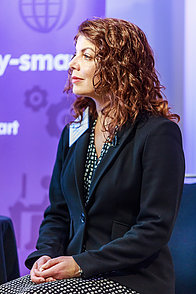Andy Ayim, Product Manager at World First, gives us a few pointers on how to align D&I measurement to business goals, ensure there is clear ownership by leaders, and make D&I a core part of your value set and culture.
Tech hubs are springing up in cities around the world as the centres of innovation as everyone is looking for that next idea, startup or innovation to breed a competitive advantage. We hear about Silicon Roundabout in Old Street, Silicon Alley in NYC and Silicon Wadi in Israel. How can global leaders in tech build more inclusive places of work for us to feel at home, add value and be ourselves whilst doing so?
Diversity and Inclusiveness (D&I) are often coupled together as terms bonded in marriage but it is important to define your distinct difference. Diversity is about bringing people together from a wide variety of backgrounds. Inclusion is about having your voices heard and acted upon. Both are important in order to create a fully inclusive culture where everyone is respected and accepted across all genders, religious beliefs, races and ability. We feel happier and more productive at work and turnover decreases as a result. McKinsey Consulting share data that inclusive teams are 22% more productive, gender diverse leadership teams show 15% higher returns, whilst ethnically diverse team outperform by 39%.
I champion a ‘diversity of thought’ as I believe there are true benefits for business and wider society if we invite different minds to the table to help think of new and different solutions.
Let’s look at Kirsten Green, founder of Forerunner Ventures and one of two women who featured on The Top 20 VC’s Worldwide list by The New York Times. She represents diversity as she had never worked at a venture capital firm before starting her own in 2012, and she is also a woman in a male-dominated field. She achieved two Billion dollar exits with Jet.com (acquired by Walmart) and Dollar Shave Club (acquired by Unilever), demonstrating the value she brings as an inclusive investor. Alternatively there is Tristan Walker, CEO and founder of consumer health and beauty brand called Walker & Co. Tristan Walker isn’t your typical Silicon Valley entrepreneur. He originates from Queens, New York and was rejected initially by a number of investors who couldn’t relate to the problem he wanted to solve. One of the first investors to understand the market opportunity and believe in Tristan was award winning New York rapper turned investor Nas (Nasir Jones). Tristan has raised over $30M building a startup dedicated to creating products for people from diverse backgrounds, embracing minorities with an inclusiveness Silicon Valley direly lacks. The question then becomes, how do we get more women like Kirsten Green to become investors or more founders like Stacey Brown-Philpot, CEO of Task Rabbit to become founders? And equally, how do we retain them?
What role can you play in improving D&I in Tech today?
We are all accountable for the lack of diversity, let alone inclusiveness in tech today, and we can all play a role in moving the dial. Inclusive teams solve problems for everyone and therefore your workplace should represent the wider working population. In 2015, Intel’s CEO Brian Krzanich made a public pledge at CES in Vegas to invest $300 million to increase diversity within the company and the tech industry at large as he recognises the business benefits. By 2020 the goal is for Intel’s workforce to be representative of the working population. Which makes sense right? you want to be in markets where your staff understands and relates to the very customers you are serving. It has great business benefits as it invites a diversity of thought to the conversation. Different thinking leads to different solutions! There are 3 steps to take from today:
- Measurement and Accountability
- Nurturing Diverse Leaders
- Creating an Inclusive Culture
Measurement and Accountability
If we look at Intel’s 2020 commitment, Intel publish a yearly report to transparently share how they are failing or succeeding called Decoded Diversity. The second thing Intel has done is raise a $125 million fund to invest in founders from diverse backgrounds such as Brit Morin from Brit + Co. What business goals align to your diversity efforts? What key performance indicators will you track? And who has ownership and responsibility for the results?
Nurturing Diverse Leaders
Change comes from the top, time and time again we hear about how startups’ culture and values are heavily reflective of the company’s founders. The first step is for leaders to believe in the benefits of D&I and share this message with staff by aligning it with business goals. Can it improve staff productivity? Attract better talent or impact growth? We need leaders to lead with empathy like the leadership development pathways provided by Pinterest’s Candice Morgan, Head of Diversity and Inclusion. Candice advocates that it is not a volume game, i.e. that simply hiring loads of under represented minorities to meet a quota isn’t going to foster a more diverse company culture. Working alongside CEO Ben Silberman, Candice and her team are executing her incremental approach for building and sustaining a diverse pipeline. Again Pinterest is a great example of transparent accountability as in 2015 they shared how they fell short in achieving their diversity goals.
Creating an Inclusive Culture
Culture should be embedded deep within the company values by leadership and your diversity advocates. Today it takes a lot more than a VC’s expertise to help startups succeed, right from the top at Board level, leaders should be thinking about filling knowledge gaps with people that represent a diversity of thought. Brit+Co provides a platform to teach, inspire and enable creativity among women and girls. It was founded by Brit Morin has raised over $25m in funding from a diverse range of investors such as Gary Vaynerchuck who immigrated from Russia to the USA (marketing guru), Marissa Mayer, President and CEO of Yahoo and one of Fast Company’s “Most Influential Women in Technology,” Tina Sharkey, the CEO of SherpaFoundry. Brit+Co’s board members represent inclusiveness with Aileen Lee, originating from China and the founder of Cowboy Ventures as well as Susan Lyne, founding Partner at BBG Ventures with a stellar track-record in digital media.
I am not a Head of Diversity & Inclusion or a 20 year veteran in building more inclusive teams, however I understand the importance of having my needs valued and the benefits for companies and society at large when we are all represented. Hiring diverse leaders from within, considering diverse executive board members, bringing in role models for Q&A’s and mentorship programs are all key. For example, I sit as an advisor to two entrepreneurs currently to provide a diversity of thought on the business problems they are trying to solve. This serves as a win-win for me as I am dedicated to increasing representation in founders and investors from diverse backgrounds in the UK.
Pick up the mantle today and work together with your hiring team and leadership to create more diverse and inclusive pathways for everyone from entry level right up to board representation. Align measurement to business goals, ensure their is clear ownership by leaders and make D&I a core part of your value set and culture.
You can read more stories about founders and investors from diverse backgrounds on Andy’s Medium here: https://medium.com/@AndysHVC, Linkedin: https://www.linkedin.com/in/andyshvc or on Twitter: https://twitter.com/AndysHVC









